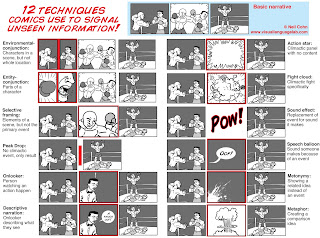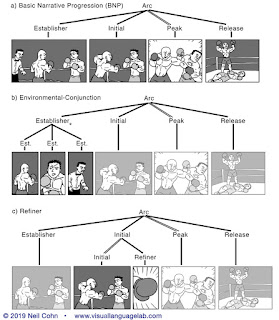2019: My publications in review
It’s now become an annual tradition for me to summarize my publications from the past year (2016, 2017, 2018). Well, 2019 has been an exciting year of papers for me, mostly because almost all of them are review papers—many of which I’d been working on for years! So, here’s what came out in 2019…
Your brain on comics (blog, open access paper) – This paper presents a model of the mechanisms the brain uses to processes a sequence of narrative images, informed by my studies on (neuro)cognition over the past 10 years. It proposes that there are two levels of representation involved in comprehension—semantics and narrative structure—and thus proposes the Parallel Interfacing Narrative-Semantics (PINS) Model. These neurocognitive mechanisms are then compared with those used in other domains, such as language processing.
Being explicit about the implicit (blog, open access paper) – Inference is often discussed about how comics communicate, but scholarship about it often remains very general. This paper categorizes specific patterns used in visual narratives to evoke inferences in a reader. Because such techniques are used (in the image to the right), it shows that inferences don’t just happen by chance, but are directed in specific ways by an author’s choices and narrative patterns.
Visual narratives and the mind (blog, pdf preprint) – This review paper explores the stages of processing involved with comprehending a sequence of images. It then explores the degree to which these mechanisms might overlap with those from other domains, such as language, and explores the stages of development that kids go through in learning to comprehend visual narratives. It’s a bit less technical than the “Your brain on comics” article, making it good for a wider audience.
The neurophysiology of event processing in language and visual events (blog, pdf paper) – This book chapter explores what neurocognitive research tells us about how we comprehend events. Specifically, it notes the similarities in neurocognitive mechanisms used to comprehend language and perceived visual events, and those drawn in visual narratives like comics.
Structural complexity in visual narratives (blog, pdf preprint) – This chapter in the book Narrative Complexity explores questions of complexity regarding the structure of narrative patterns. I explore how various narrative schema combine to create complex patterns (image to the right), and then do a cross-cultural analysis of those patterns to show that they differ in how much they are used between Western and Asian comics. I then close with a review of the neurocognition of visual narratives.
Visual narrative comprehension: Universal or not? (blog, open access paper) – This review paper asks to what degree visual narrative sequences are universally transparent to understand. I review cross-cultural work on people who have difficulty comprehending sequences of images, developmental work on when children start comprehending image sequences, and clinical work on autism, developmental language disorder, and aphasia examining the limitations of their comprehension. These results all show that understanding sequential images requires a fluency acquired from exposure to comics and drawn visual narratives.
Besides these papers, I was ecstatic to learn I’d received an ERC Starting Grant along with some other funding for projects related to visual narratives and autism (with Emily Coderre and co.) and developmental language disorder (with Annika Anderson and co.). So, here’s looking forward to an exciting 2020!


Comments